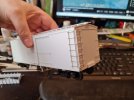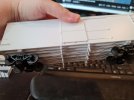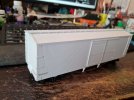You are using an out of date browser. It may not display this or other websites correctly.
You should upgrade or use an alternative browser.
You should upgrade or use an alternative browser.
Amanda's Workshop: Scratchbuilding Toward A Layout
- Thread starter WM183
- Start date
timbowales
Western Thunderer
Excellent work, AmandaThe New York Central truss rod boxcar is nearing completion. The truss rods have been installed, the roof walk added, and the ladders and grab irons installed. A few details are left to add, such as stirrup steps, brake shaft and platform, and so on, but it's 95% done!
View attachment 207667View attachment 207668View attachment 207669
Tim T
WM183
Western Thunderer
Excellent work, Amanda
Tim T
Thank you!
I also have been building a little h0 mockup of a Pittsburg Shawmut & Northern wooden coal hopper. I've not scratchbuilt a hopper before, and before tackling a half dozen of these in 0 scale, I wanted to sort out how the slope sheets, etc fit together, and how to shape them.
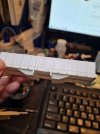
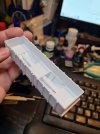
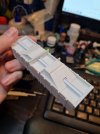
WM183
Western Thunderer
I FOUND THEM!
Aha! I found an article in an old AERJ (American Engineering & Railroad Journal) hosted on Haithitrust that had all the diagrams one could ever hope for to build one of the bigger, later PRR 2-8-0s. I now have a general elevation drawing as well as frame, boiler, and cylinder arrangements, ashpan arrangement, some detail bits... everything I could hope for.
As the H8/9/10, at least in Lines East, used the same tender as the E6, I have drawings for this too.
It felt like discovering the lost lore of the library of Alexandria, finding this!
What this means is that I now have sufficient information to build H8/9/10 2-8-0s, L1 2-8-2s, and even the big Hippos, the I1 class 2-10-0s if I decide to, 3 of the 4 main types used on the Wilkes Barre division. That leaves just B6, which I do have one elevation drawing for that I could probably work from. I also have GAs for every type of freight car likely to be introduced to the line between 1900 and 1925 or so. Some of the very old types are unknowns, but by the time of my 1917 Official Railway Equipment Register, modern steel framed or all steel cars were an overwhelming majority and cars with wood underframes were outlawed in 1920 or 1921 anyway, so those old sorts would be long gone. I need to find a 1925ish ORER.
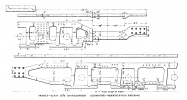
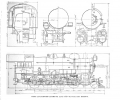
Aha! I found an article in an old AERJ (American Engineering & Railroad Journal) hosted on Haithitrust that had all the diagrams one could ever hope for to build one of the bigger, later PRR 2-8-0s. I now have a general elevation drawing as well as frame, boiler, and cylinder arrangements, ashpan arrangement, some detail bits... everything I could hope for.
As the H8/9/10, at least in Lines East, used the same tender as the E6, I have drawings for this too.
It felt like discovering the lost lore of the library of Alexandria, finding this!
What this means is that I now have sufficient information to build H8/9/10 2-8-0s, L1 2-8-2s, and even the big Hippos, the I1 class 2-10-0s if I decide to, 3 of the 4 main types used on the Wilkes Barre division. That leaves just B6, which I do have one elevation drawing for that I could probably work from. I also have GAs for every type of freight car likely to be introduced to the line between 1900 and 1925 or so. Some of the very old types are unknowns, but by the time of my 1917 Official Railway Equipment Register, modern steel framed or all steel cars were an overwhelming majority and cars with wood underframes were outlawed in 1920 or 1921 anyway, so those old sorts would be long gone. I need to find a 1925ish ORER.


Last edited:
WM183
Western Thunderer
In the United States, particularly in the industrial northeast (where I am from) there were two 500-pound gorillas with respect to railroads; the Pennsylvania Railroad, and the New York Central System. The PRR was slightly bigger - in 1927 they rostered 266,624 freight cars and somewhere on the order of 5000 locomotives. The New York Central was second only to the PRR - the NYC had 220k or so freight cars, roughly the same number of locomotives (the NYC had a LOT more switchers. or "shifters" in PRR parlance, than the PRR) and carried about 80% of the freight ton-miles the PRR did... and both were several times larger than the nearest competitors.
Modelling the northeastern US in the 1920s means you're both a PRR and a NYC modeller, whether or not you wish to be. Think of them as the LMS and LNER of the US at the time; their cars were *everywhere* and dominant. These two roads alone might make up 50% of the cars in any given train, even if the railroad operating the train were part of neither system.
The PRR is lovely to model; they followed a very regimented and ordered path of improvements. When they found a car type that worked for them, they built them by the tens of thousands; literally. The 10 most common classes on the PRR accounted for more than 80% of the 1920s freight car fleet, with some individual types (GL/GLa hoppers, GR/GRa gondolas, and XL boxcars) numbering 30000 or more. Thus, one need only build a few model types to quite accurately represent the PRR. They ordered locomotives of a single type for most given wheel arrangements, and they ordered a LOT of them. In the 1920s, the PRR was run with a handful of types of engines, with hundreds of a given type.
The New York Central... did not do this.
Not only did the NYC buy cars in orders of 500 to 1000 at a time, most of the time, they went through near constant revisions and design changes. The NYC did not have a nice, user friendly car classification system as did the PRR. Cars were arranged by the lot number they were ordered under and these orders number in the hundreds. In addition, cars were spread across the sprawling New York Central system, which included both the New York Central itself (itself an amalgamation of the Lake Shore & Michigan Southern and the New York Central and Hudson River systems) as well as the Big Four, the Michigan Central, the Peoria and Eastern Illinois, the Canada Southern, the Pittsburgh and Lake Erie, and numerous other smaller divisions. Their engines underwent a bewildering array of updates, upgrades, sidegrades, modifications, and changes which make any attempt to comprehend them something of a hair pulling event.
I am attempting to build something of a compliation of the "signature" cars the NYC used that I might wish to model. They seem to have used a handful of types. Boxcars in the 1920s would be of a few major types; 36 foot double sheathed cars and 40 foot all steel USRA cars, as well as 40 foot steel framed automobile boxcars. Gondolas seem to be of two types; 40 foot steel ones with hopper bottoms, and 42 foot composite ones. Hopper cars were almost all of various twin hopper types between 30 and 31 feet long. But how many of each type? Who knows?
Why do we as model railroaders think about this stuff?
Who knows.
Modelling the northeastern US in the 1920s means you're both a PRR and a NYC modeller, whether or not you wish to be. Think of them as the LMS and LNER of the US at the time; their cars were *everywhere* and dominant. These two roads alone might make up 50% of the cars in any given train, even if the railroad operating the train were part of neither system.
The PRR is lovely to model; they followed a very regimented and ordered path of improvements. When they found a car type that worked for them, they built them by the tens of thousands; literally. The 10 most common classes on the PRR accounted for more than 80% of the 1920s freight car fleet, with some individual types (GL/GLa hoppers, GR/GRa gondolas, and XL boxcars) numbering 30000 or more. Thus, one need only build a few model types to quite accurately represent the PRR. They ordered locomotives of a single type for most given wheel arrangements, and they ordered a LOT of them. In the 1920s, the PRR was run with a handful of types of engines, with hundreds of a given type.
The New York Central... did not do this.
Not only did the NYC buy cars in orders of 500 to 1000 at a time, most of the time, they went through near constant revisions and design changes. The NYC did not have a nice, user friendly car classification system as did the PRR. Cars were arranged by the lot number they were ordered under and these orders number in the hundreds. In addition, cars were spread across the sprawling New York Central system, which included both the New York Central itself (itself an amalgamation of the Lake Shore & Michigan Southern and the New York Central and Hudson River systems) as well as the Big Four, the Michigan Central, the Peoria and Eastern Illinois, the Canada Southern, the Pittsburgh and Lake Erie, and numerous other smaller divisions. Their engines underwent a bewildering array of updates, upgrades, sidegrades, modifications, and changes which make any attempt to comprehend them something of a hair pulling event.
I am attempting to build something of a compliation of the "signature" cars the NYC used that I might wish to model. They seem to have used a handful of types. Boxcars in the 1920s would be of a few major types; 36 foot double sheathed cars and 40 foot all steel USRA cars, as well as 40 foot steel framed automobile boxcars. Gondolas seem to be of two types; 40 foot steel ones with hopper bottoms, and 42 foot composite ones. Hopper cars were almost all of various twin hopper types between 30 and 31 feet long. But how many of each type? Who knows?
Why do we as model railroaders think about this stuff?
Who knows.
garethashenden
Western Thunderer
Are you familiar with the Canadian Southern website? They have a detailed NYC freight car roster. There's a passenger car one too actually.
WM183
Western Thunderer
I am!Are you familiar with the Canadian Southern website? They have a detailed NYC freight car roster. There's a passenger car one too actually.
This is the site I am using to sort of compile what the NYC freight car fleet might have looked like circa 1925 or so. Conveniently, lot 499-H is the first lot of 1925, so will be my cutoff date for my compilation. I am going under the assumption that cars predating 1900 will have been culled following USRA control, and if not, the impending ban on wooden center sills in 1928 will kill whatever stragglers remain. Likewise, any wooden coal gons would be long gone by this time; between the action of the elements around the Great Lakes, and the rough service they saw, the LSMS' wooden coal gons were long gone before WWI. Thus, any of the lots of those cars can be discounted.
So, I'll be tallying up steel framed or all steel cars, between lot 204G - the central's first steel framed cars - and lot 499. Some of the earlier truss rod boxcars did get steel underframes in the 1920s to prepare for the wood sill ban, but we will just assume they're in a small quantity.
garethashenden
Western Thunderer
I think 1928 was the ban on new construction with wood underframes. I think existing cars weren't banned from interchange until 1935. The Boston & Maine certainly had hundreds of 36' WUF boxcars in service through 1935, and zero in 1936. So if you're modelling the '20s then I think a fair number of WUF cars would be appropriate. Looking at the first lot on the Canadian Southern page, 200-B, they were 36' all wood boxcars in service from 1906-1937. Its noted that some were converted to steel underframes 1923-1930. That would tie in with an ICC ban on wood underframes in 1935. Nothing to stop the Central from using them online after that, they just can't interchange them.
Last edited:
Jordan
Mid-Western Thunderer
"Sidegrades"...Their engines underwent a bewildering array of updates, upgrades, sidegrades, modifications, and changes
 not heard that word before, love it!!
not heard that word before, love it!! 

WM183
Western Thunderer
Yeah, the New York Central did a lot of stuff to their engines that often seems like it was done simply to expend money in the renewal budget."Sidegrades"...not heard that word before, love it!!


Hawkeye
Member
I had coupling rods laser cut in 2mm thick mild steel by PPD Ltd: PPD - Model Rail
They can laser cut Brass up to 4mm thick, Mild Steel up to 6mm thick but Nickel Silver only up to 0.9mm thick.
Looking awfully good!
But how is the flatness of these parts? And the concistency when you compare them? I also wonder if anyone have tried to mill flutes or other features into such parts, and how that affects flatness.
PhilH
Western Thunderer
Looking awfully good!
But how is the flatness of these parts? And the concistency when you compare them? I also wonder if anyone have tried to mill flutes or other features into such parts, and how that affects flatness.
Flatness: I can't say for thinner material but for my example in 2mm mild steel - dead flat
Consistency: Perfect
I didn't need flutes but I machined them thinner between the bosses on both sides with no problems - still dead flat
Hawkeye
Member
Thanks a lot!Flatness: I can't say for thinner material but for my example in 2mm mild steel - dead flat
Consistency: Perfect
I didn't need flutes but I machined them thinner between the bosses on both sides with no problems - still dead flat
That was precisely what I wanted to hear. A great inspiration to restart my project.

